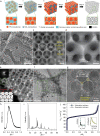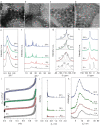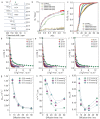Boosting molecular diffusion following the generalized Murray's Law by constructing hierarchical zeolites for maximized catalytic activity
- PMID: 36632521
- PMCID: PMC9828477
- DOI: 10.1093/nsr/nwac236
Boosting molecular diffusion following the generalized Murray's Law by constructing hierarchical zeolites for maximized catalytic activity
Abstract
Diffusion is an extremely critical step in zeolite catalysis that determines the catalytic performance, in particular for the conversion of bulky molecules. Introducing interconnected mesopores and macropores into a single microporous zeolite with the rationalized pore size at each level is an effective strategy to suppress the diffusion limitations, but remains highly challenging due to the lack of rational design principles. Herein, we demonstrate the first example of boosting molecular diffusion by constructing hierarchical Murray zeolites with a highly ordered and fully interconnected macro-meso-microporous structure on the basis of the generalized Murray's Law. Such a hierarchical Murray zeolite with a refined quantitative relationship between the pore size at each length scale exhibited 9 and 5 times higher effective diffusion rates, leading to 2.5 and 1.5 times higher catalytic performance in the bulky 1,3,5-triisopropylbenzene cracking reaction than those of microporous ZSM-5 and ZSM-5 nanocrystals, respectively. The concept of hierarchical Murray zeolites with optimized structural features and their design principles could be applied to other catalytic reactions for maximized performance.
Keywords: catalytic cracking; generalized Murray's Law; hierarchical Murray structure; ordered porous hierarchy; zeolites.
© The Author(s) 2022. Published by Oxford University Press on behalf of China Science Publishing & Media Ltd.
Figures




Similar articles
-
Micron-Sized Zeolite Beta Single Crystals Featuring Intracrystal Interconnected Ordered Macro-Meso-Microporosity Displaying Superior Catalytic Performance.Angew Chem Int Ed Engl. 2020 Oct 26;59(44):19582-19591. doi: 10.1002/anie.202007069. Epub 2020 Aug 6. Angew Chem Int Ed Engl. 2020. PMID: 32643251
-
Hierarchically Structured Zeolites: From Design to Application.Chem Rev. 2020 Oct 28;120(20):11194-11294. doi: 10.1021/acs.chemrev.0c00016. Epub 2020 Sep 11. Chem Rev. 2020. PMID: 32915551 Review.
-
Plate-Like ZSM-5 Zeolites as Robust Catalysts for the Cracking of Hydrocarbons.ACS Appl Mater Interfaces. 2022 Mar 9;14(9):11415-11424. doi: 10.1021/acsami.1c23614. Epub 2022 Feb 28. ACS Appl Mater Interfaces. 2022. PMID: 35226463
-
Anchoring Cu sites in a hierarchical single-crystalline ZSM-5 zeolite for enhanced diffusion and benzene oxidation.Dalton Trans. 2025 May 13;54(19):7734-7740. doi: 10.1039/d5dt00442j. Dalton Trans. 2025. PMID: 40259767
-
π-π Interactions Between Aromatic Groups in Amphiphilic Molecules: Directing Hierarchical Growth of Porous Zeolites.Angew Chem Int Ed Engl. 2020 Jan 2;59(1):50-60. doi: 10.1002/anie.201903364. Epub 2019 Oct 31. Angew Chem Int Ed Engl. 2020. PMID: 31059172 Review.
Cited by
-
Polyphenol-Derived Carbonaceous Frameworks with Multiscale Porosity for High-Power Electrochemical Applications.Adv Mater. 2025 Jul;37(26):e2406251. doi: 10.1002/adma.202406251. Epub 2024 Jul 30. Adv Mater. 2025. PMID: 39078377 Free PMC article. Review.
-
Maximizing catalytic efficiency with bio-inspired hierarchical porous zeolites.Natl Sci Rev. 2023 May 25;10(7):nwad155. doi: 10.1093/nsr/nwad155. eCollection 2023 Jul. Natl Sci Rev. 2023. PMID: 37377848 Free PMC article. No abstract available.
-
Universal Murray's law for optimised fluid transport in synthetic structures.Nat Commun. 2024 May 7;15(1):3652. doi: 10.1038/s41467-024-47833-0. Nat Commun. 2024. PMID: 38714661 Free PMC article.
References
-
- Li K, Valla J, Garcia-Martinez J. Realizing the commercial potential of hierarchical zeolites: new opportunities in catalytic cracking. ChemCatChem 2014; 6: 46–66. 10.1002/cctc.201300345 - DOI
LinkOut - more resources
Full Text Sources
